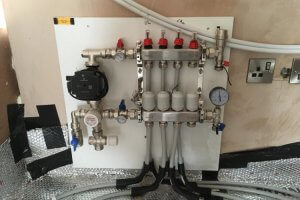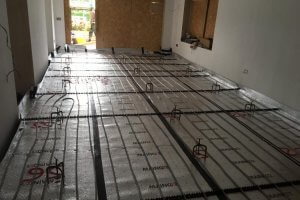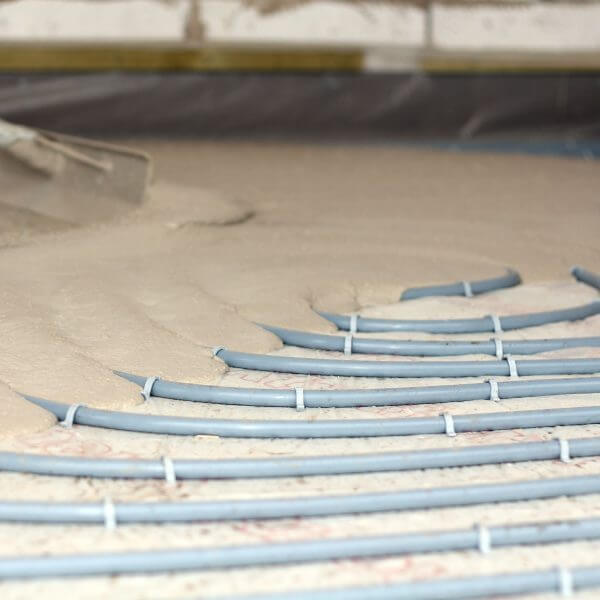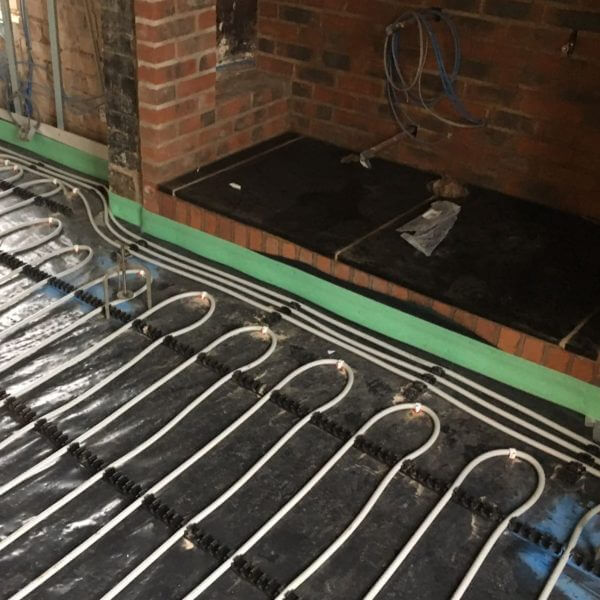Underfloor Heating Liverpool
Installing an Underfloor Heating System in Liverpool Discussed by Easyflow

As most properties (especially in the past) utilise traditional heating systems such as a central heating systems using radiators, there were few alternatives to heating your property or premises. Although not a new concept, (with the Romans being credited for creating the first underfloor heating systems!) it’s no surprise that underfloor heating systems have become more and more popular as an alternative, (or in addition) to central heating systems. With a number of modern innovations that make underfloor heating systems even more effective and easy to use, considering the installation of a UFH heating system is a great way to heat your property or business premises. Easyflow are one of the leading providers of underfloor heating in Liverpool.
Offering a variety of underfloor heating systems as well as floor screed, we can work with you from the beginning of your enquiry to the commissioning of your underfloor heating system and liquid screed. In this article, we discuss the reasons as to why you may want to install an underfloor heating system in your property as well as why installing a package of underfloor heating and liquid screed is such an effective heating solution for your property. If you are looking for underfloor heating in Liverpool or UFH in Liverpool then enquire with Easyflow using an online contact form on our website or telephone our team directly now on: 01513176072
Installing an Underfloor Heating System in Your Property
Underfloor heating is a modern heating system that can greatly increase the comfort that you have in your home. A highly popular installation option in new-build properties, underfloor heating combined with anhydrite liquid screed is vastly superior in thermal efficiency in comparison to more traditional heating methods. When considering installing an underfloor heating system, you are likely thinking about the type of flooring that you have available in your property and the type of flooring that you is appropriate for your underfloor heating system. We highly recommend anhydrite liquid floor screed for use in underfloor heating systems. This is because this guarantees to make your underfloor heating system as thermally efficient as possible and allows for a shallower installation of your underfloor heating system should you require this.
Liquid Screed Vs Sand Cement
When considering the flooring options for your flooring or underfloor heating system, liquid screed offers a wide range of benefits in comparison to traditional sand cement screed. As we have already mentioned the thermal efficiency of liquid screed, this material has a 2.2W/mK thermal conductivity (quantity of heat transferred through a set of thickness over a set period of time.) This has reduced coverage over heating pipes and in comparison sand cement screed offers 1.1W/mK thermal conductivity. Liquid screed makes your underfloor heating system more thermally efficient, saving you money on energy bills. You can walk upon liquid screed within 24-48 hours and is self-curing whereas sand cement screed takes 7 days before you can walk on the floor and requires covering to cure. Additionally to this, the typical during time for liquid screed is 40 days at 40mm and can be forced to dry after 7 days. Sand cement screed on the other hand will take 65 days to dry at 65mm, cannot be forced dried and should be cured for one week.
Liquid screed offers a greater compressive and flexural strength compared to sand cement screed with normal shrinkage and the screed will not curl. The shrinkage and curls that occur with sand cement screed can result in cracking or damage of the sand cement screed floor. The amount of liquid screed that can be laid is vastly superior to sand cement screed with the ability to be able to lay up to 1500m2 per day of liquid screed compared to just only 150m2 per day of sand cement screed. This increases the productivity of your project and rapidly increases the speed in which one can complete a flooring project. 1 tonne of binder = 980kg of recycled material and the average screed recycled is 36%. 1 tonne of cement = 1500kg of raw material and the average screed recycled is 0%. Liquid screed is ergonomically friendly and you are not at risk of cement burns when laying liquid screed. You are at risk of cement burns when laying sand cement screed and the laying process is very labour intensive. The installation of liquid screed flooring is produced to BS EN 13454 and designed to BS8204:7 and the screed is self-compacting. Sand cement screed on the other hand is often mixed by hand on site which produces an inconsistent quality and the sand cement screed requires extensive compaction.
What Does This Mean For Your Project?
The main benefits are that you get a much better product and a floor in which you can achieve an SR2 surface finish under BS 8204. It depends on the contractor as to what finish is available for sand cement screed flooring. There is no risk of shrinkage and curling of your floor when you install a liquid screed floor and you are using a product that is vastly more environmentally friendly than sand cement screed. The ability to walk upon the liquid screed floor within 24-48 hours ensures minimal disruption to others that may working on the project. The disruption that can be caused by a 7 day wait to walk on a sand cement screed floor can be hugely impactful and bring work to a standstill if the flooring has to be installed before other work can be carried out. The quality of installation of liquid screed is unparalleled whereas the quality of work that is achieved with sand cement screed leaves much to be desired.
In regards to your underfloor heating system, it’s highly important that you have a wonderful flooring area to go along with your underfloor heating system. Liquid screed is the perfect solution and goes hand in hand with underfloor heating systems. The thermal efficiency is vastly superior and there are a wide range of installation options to go along with your underfloor heating system when you choose to install this with liquid screed. Being innovative and more effective than more traditional methods, liquid screed is highly recommended in comparison to more traditional screeding materials and methods.
Install Your Underfloor Heating System in Liverpool Today

If you are looking to enjoy the benefits of an underfloor heating system in conjunction with your central heating or are looking to overhaul your current heating system then Easyflow are here to advise and help you install the perfect underfloor heating system. We have worked with many clients in Liverpool and the surrounding areas and pride ourselves on the quality and service that we provide within an industry where standards are exacting. We will work with you from your initial enquiry to the commissioning of your underfloor heating system. We highly recommend installing liquid screed along with your underfloor heating system in comparison to other more traditional screeds such as sand cement screed for the best results. If you are looking for underfloor heating in Liverpool or underfloor heating near me in Liverpool then enquire with Easyflow using an online contact form on our website or telephone now on: 01513176072




Where To Find Us